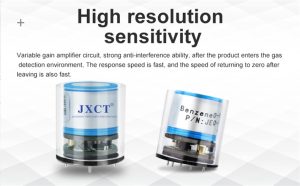-
Advances in Gas Sensor Technology: Improving Air Quality Monitoring and Pollution Control
- Air pollution is a pressing global issue that affects the health and well-being of both humans and the environment. To tackle this problem effectively, accurate air quality monitoring and effective pollution control measures are crucial. ……
- Chat Online
-
Description
Air pollution is a pressing global issue that affects the health and well-being of both humans and the environment. To tackle this problem effectively, accurate air quality monitoring and effective pollution control measures are crucial. Gas sensor technology has played a significant role in advancing air quality monitoring and pollution control. This article explores the recent advances in gas sensor technology and how they contribute to improving air quality monitoring and pollution control efforts.
Importance of Air Quality Monitoring:
Air quality monitoring is essential for assessing the levels of pollutants present in the atmosphere. It helps to understand the sources, distribution, and impact of pollutants, enabling authorities to implement appropriate pollution control measures. Traditional air quality monitoring systems often rely on large-scale stationary monitors, which have limitations in terms of coverage and real-time data availability. Gas sensor technology offers a more flexible and efficient approach to air quality monitoring.

Types of Gas Sensors:
Gas sensors are devices that detect and measure the concentration of specific gases in the environment. There are various types of gas sensors available, including electrochemical sensors, photoionization detectors (PID), metal oxide sensors, and infrared sensors. Each type of sensor has its advantages and is suitable for detecting different types of gases. Recent advances in gas sensor technology have focused on enhancing sensitivity, selectivity, and response time.
Miniaturization and Portability:
One significant advancement in gas sensor technology is the miniaturization and portability of sensors. Miniaturized gas sensors are now small enough to be integrated into wearable devices or deployed in a network of compact, distributed sensors. This enables real-time, fine-grained monitoring of air quality in various environments, including industrial sites, urban areas, and indoor spaces. Portable gas sensors provide flexibility and mobility for on-the-spot measurements and can be used for personal exposure monitoring.
Internet of Things (IoT) Integration:
Gas sensors can be seamlessly integrated into the Internet of Things (IoT) ecosystem, allowing for remote monitoring and data collection. IoT-enabled gas sensor networks provide real-time data on air quality, which can be aggregated and analyzed to identify pollution hotspots, trends, and patterns. This information is invaluable for urban planners, policymakers, and researchers in developing effective pollution control strategies and policies.
Multi-Gas Detection and Selectivity:
Advancements in gas sensor technology have also focused on multi-gas detection capabilities. Traditional gas sensors were often limited to detecting a specific gas or a narrow range of gases. However, recent developments have led to the development of gas sensors that can detect multiple gases simultaneously. These multi-gas sensors enhance efficiency and cost-effectiveness by reducing the number of individual sensors required for comprehensive air quality monitoring.
Enhanced Sensitivity and Accuracy:
Improved sensitivity is a crucial aspect of gas sensor technology. It allows for the detection of lower concentrations of pollutants, thereby providing more accurate measurements of air quality. Advances in sensor materials, such as nanomaterials and graphene, have significantly enhanced the sensitivity and selectivity of gas sensors. These advancements enable the detection of even trace amounts of pollutants, ensuring more precise monitoring and control of air quality.
Real-Time Data and Analytics:
Gas sensors generate a vast amount of data that can be analyzed to gain insights into air quality patterns and trends. With advances in data analytics techniques, it is now possible to process and analyze this data in real-time. Machine learning algorithms and artificial intelligence enable the identification of complex patterns and correlations between air quality parameters and pollutant sources. This information can guide decision-making and facilitate rapid responses to mitigate air pollution.
Integration with Pollution Control Measures:
Gas sensor technology can play a crucial role in improving pollution control measures. By providing real-time data on pollutant levels, gas sensors can help identify emission sources, assess the effectiveness of pollution control measures, and facilitate targeted interventions. This integration enables a feedback loop between air quality monitoring and pollution control, ensuring continuous improvement in air quality management.

Conclusion:
Advances in gas sensor technology have revolutionized air quality monitoring and pollution control efforts. With miniaturization, portability, IoT integration, multi-gas detection capabilities, enhanced sensitivity, and real-time data analytics, gas sensors offer more accurate, efficient, and cost-effective solutions for monitoring air quality. I
-
Recommend:
-
-
Gas detectors are crucial devices used in various industrie…
-
How do gas detectors ensure industrial safety?
Gas detectors play a crucial role in ensuring the safety of…
-
How Gas Sensors Help Combat Air Pollution?
Air pollution is a pressing global issue that poses signifi…
-
How can gas sensors be used in air quality monitoring?
Air pollution is a significant global concern that affects …
-
 : +86 155 8830 2704
: +86 155 8830 2704 : jxdziot@gmail.com
: jxdziot@gmail.com
